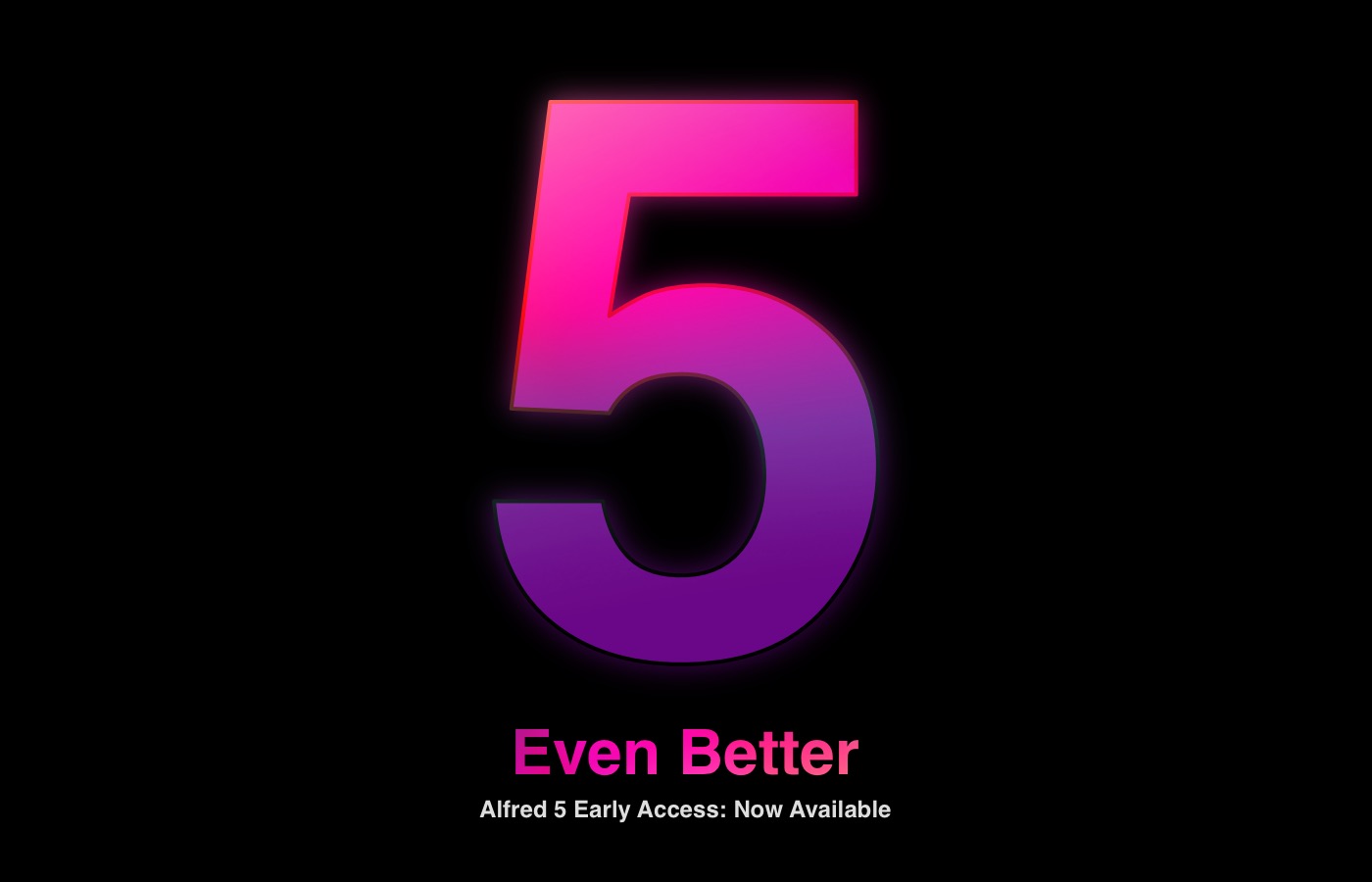Following our feature-filled and stable Alfred 5 release, we bring you 5.0.1 which fixes a few spellings, tweaks a few features, and improves accessibility even further.
It's been brilliant to see your workflows, old and new, using Automation Tasks and taking advantage of the new User Configuration feature shared with the world.
In particular, we'd like to tip our bowler hat to the Mega Supporters who upgraded their license to the Legendary Supporter - We thank you for your ongoing support through the years! :)
We have an exceptionally exciting roadmap for Alfred 5, and can't wait to bring you even more productivity in 2022 and beyond!

After many months of development and a brilliant Early Access release, we're excited to announce Alfred 5 is now available to all!
It was great to see such an enthusiastic take-up by the community during Early Access, who have really helped us put Alfred 5 through its paces in preparation for this General Release.
Ready to jump in with the new features? Download Alfred 5 from our website; You can grab a new Powerpack license or upgrade your existing license to unlock the Powerpack features.
Take a look at What's New in Alfred 5 to the discover the rewritten Workflow Editor, which is easier to use than ever, the fantastic Palette Search, the new Automation Tasks which help you write codeless workflows, and so much more!
We've published an Alfred 5 Getting Started post with the licensing FAQ.

What are you waiting for? Join the Alfred community in enjoying the new Alfred 5 features! :)
Alfred 5 is now available; Here's a quick guide to getting started with this new version so that you can jump in right away.
Take a look at What's new in Alfred 5 to discover the many new features we've added, including the rewritten Workflow Editor, which is easier to use than ever, the fantastic Palette Search, the new Automation Tasks which help you write codeless workflows, and so much more!
Grab a new Powerpack license or upgrade your existing license to unlock the Powerpack features.
Where can I download Alfred 5?
From the Alfred homepage, install the free version of Alfred 5 to get started.
On first launch, Alfred's Migration Assistant will walk you through activating your Powerpack license, migrating your existing preferences and granting a few permissions.

How do I activate my Powerpack license?
If you purchased your Alfred 4 license in 2022 or are a Mega Supporter, you get a free upgrade to Alfred 5. Enter your details here to request your Alfred 5 license, which will be emailed to you.
If you purchased your license before 2022 and are not a Mega Supporter, you are eligible for a discounted upgrade.
Finally, if you're new to the Alfred community, what are you waiting for? You can purchase a Powerpack license today to get access to numerous great features like workflows, clipboard history, snippets, custom theming, file navigation and so much more!
I need to recover my license, or I'm not sure which license I have
Please take a good look in your inbox(es) for the subject line "Your Alfred License", as you'll have received a copy of your license by email.
If you're unable to locate your details, get in touch from your registered email address, and we'll get back to you as soon as possible. (Please be patient during this busy time, we'll aim to get back to you as soon as we can.)
Let's get started
Ready to jump in and boost your productivity with the new Alfred 5 features? You can see the full range of features on the What's New in Alfred 5 page.
When creating the "What's New" page for Alfred 5, it felt tricky to convey the sheer time and effort we have put into rebuilding the Workflow Editor from scratch over the past year to make it more approachable and accessible for users of all experience levels and backgrounds.
That's why it was so great to see the following comment on the Alfred forum yesterday:
Skeptic to Believer in 20 Minutes
I'll admit to being underwhelmed when I saw the Alfred 5 feature list. Then I tried the Alfred 5 Preview and within 20 minutes created a workflow I'd been wanting for years (controlling lights via HomeKit). The new workflow creator is a pleasure to use! I have only the most basic skills with programming, little patience for scripting, and low imagination for automation, and it was still pretty easy with a little bit of Googling. Excited to try more!
- Dan Blondell
Thanks to everyone who is taking part in the Early Access; The enthusiasm and positive feedback from our brilliant community has been excellent.
Over the coming months, we will be sharing tips, tricks and a more in-depth look at the new Alfred 5 features, including how to get the most out of building your own workflows.
At the same time, we will be further growing the library of tasks for the new Automation Task object, a key object in empowering non-coders to create more advanced workflows than ever.

Earlier today, we announced that Alfred 5 is now available for those who'd like to take part in our Early Access.
Can't wait? Grab an Alfred 5 license and download the Early Access build here to get started right away!
Our closed beta group has been testing Alfred 5 for a few weeks now, and have reported great performance and stability, so there's no need to hesitate if you'd like to jump into the new features.
Take a look at the Early Access information for an FAQ on migrating your preferences and details on using the new features.
We'll be sharing more documentation on Alfred 5 features in the coming weeks. In the meantime, you can say hi on Twitter at @alfredapp and on the Alfred forum.





